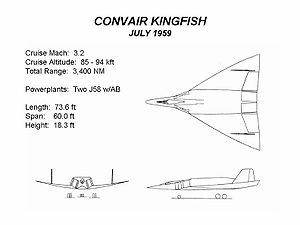Convair Kingfish
| Kingfish | |
|---|---|
 |
|
| Kingfish design (July 1959) | |
| Role | Reconnaissance aircraft |
| National origin | United States of America |
| Manufacturer | Convair |
| Status | Cancelled |
| Primary user | Central Intelligence Agency |
| Number built | 0 |
The Convair Kingfish reconnaissance aircraft design was the ultimate result of a series of proposals designed at Convair as a replacement for the Lockheed U-2. Kingfish competed with the Lockheed A-12 for the Project Oxcart mission, and lost to that design in 1959.
Before the U-2 became operational in June 1956, CIA officials had estimated that the U-2's life expectancy for its particular airframe design to be able to fly safely over the Soviet Union would be between 18 months and two years. After overflights began and the Soviets demonstrated the ability to track and attempt to intercept the U-2, this estimate was adjusted downward. In August 1956, Richard Bissell reduced the number to six months.
To extend the useful life of the U-2, the CIA started Project Rainbow, which added various countermeasures to confuse the Soviet radars and make planning an intercept more difficult. The anti-radar methods developed under Rainbow consisted of, first, a diffusing coating for the fuselage, and, second, a series of wires strung along the fuselage and the wing edges that were supposed to cancel out radar reflection from the airframe by "broadcasting" a similar return but out-of-phase. Several Rainbow-equipped flights were made, but the Soviets proved able to track the aircraft regardless. The weight of the equipment also had the side-effect of lowering the aircraft's maximum cruise altitude, making it more vulnerable to interception. Rainbow was canceled in 1958.
As early as 1956 Bissell had already started looking for an entirely new aircraft to replace the U-2, with an emphasis on reducing the radar cross-section as much as possible. High-altitude flight would still be useful to avoid interception by aircraft, but did little to help against missiles. By reducing the RCS, the radars guiding the missiles would have less time to track the aircraft, complicating the attack.
In August 1957 these studies turned to examining supersonic designs, as it was realized that supersonic aircraft were very difficult to track on radars of that era. This was due to an effect known as the blip-to-scan ratio, which refers to the "blip" generated by an aircraft on the radar display. In order to filter out random noise from the display, radar operators would turn down the amplification of the radar signal so that fleeting returns would not be bright enough to see. Returns from real targets, like an aircraft, would become visible as multiple radar pulses all drawn onto the same location on the screen, and produced a single brighter spot. If the aircraft is moving at very high speeds, the returns would be spread out on the display. Like random noise, these returns would become invisible.
...
Wikipedia
